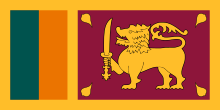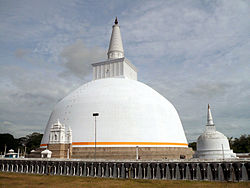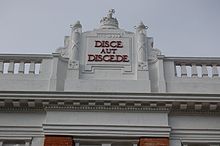Portal:Sri Lanka
The Sri Lanka Portal Sri Lanka, historically known as Ceylon and officially the Democratic Socialist Republic of Sri Lanka, is an island country in South Asia. It lies in the Indian Ocean, southwest of the Bay of Bengal, separated from the Indian peninsula by the Gulf of Mannar and the Palk Strait. It shares a maritime border with the Maldives in the southwest and India in the northwest. Sri Lanka has a population of approximately 22 million and is home to many cultures, languages and ethnicities. The Sinhalese people form the majority of the population, followed by the Sri Lankan Tamils, who are the largest minority group and are concentrated in northern Sri Lanka; both groups have played an influential role in the island's history. Other long-established groups include the Moors, Indian Tamils, Burghers, Malays, Chinese, and Vedda. Sri Lanka's documented history goes back 3,000 years, with evidence of prehistoric human settlements dating back 125,000 years. The earliest known Buddhist writings of Sri Lanka, known collectively as the Pāli canon, date to the fourth Buddhist council, which took place in 29 BCE. Also called the Pearl of the Indian Ocean, or the Granary of the East, Sri Lanka's geographic location and deep harbours have made it of great strategic importance, from the earliest days of the ancient Silk Road trade route to today's so-called maritime Silk Road. Because its location made it a major trading hub, it was already known to both East Asians and Europeans as long ago as the Anuradhapura period. During a period of great political crisis in the Kingdom of Kotte, the Portuguese arrived in Sri Lanka and sought to control its maritime trade, with a part of Sri Lanka subsequently becoming a Portuguese possession. After the Sinhalese-Portuguese war, the Dutch Empire and the Kingdom of Kandy took control of those areas. The Dutch possessions were then taken by the British, who later extended their control over the whole island, colonising it from 1815 to 1948. A national movement for political independence arose in the early 20th century, and in 1948, Ceylon became a dominion. It was succeeded by the republic of Sri Lanka in 1972. Sri Lanka's more recent history was marred by a 26-year civil war, which began in 1983 and ended in 2009, when the Sri Lanka Armed Forces defeated the Liberation Tigers of Tamil Eelam. (Full article...) Selected article -Royal College, Colombo (Sinhala: රාජකීය විද්යාලය, Tamil: ரோயல் கல்லூரி also known as; Royal Colombo, Colombo Royal College or Colombo Royal) is a selective entry boys' school located in Cinnamon Gardens, Colombo, Sri Lanka. Started by Joseph Marsh in 1835, it was established as the Colombo Academy by Sir Robert Wilmot-Horton in January 1836, as part of the implementation of the recommendations of the Colebrooke Cameron Commission (1833), and was the first government-run secondary school for boys in the island. Royal College is the first public school in Sri Lanka and is often referred to as the "Eton of Sri Lanka". The school was founded in the British public school tradition, based on the recommendations of the Colebrooke Cameron Commission (1833), and having been named the Royal College, Colombo in 1881 with consent from Queen Victoria, it became the first school to gain the prefix, "Royal", outside of the British Isles and it was one of the first schools to be designated as a national school by the Sri Lankan Government in the 1980s. (Full article...)General imagesThe following are images from various Sri Lanka-related articles on Wikipedia.
Related portalsIndian Subcontinent Other countries Selected biography -Parākramabāhu I (Sinhala: මහා පරාක්රමබාහු, c. 1123–1186), or Parakramabahu the Great, was the king of Polonnaruwa from 1153 to 1186. He oversaw the expansion and beautification of his capital, constructed extensive irrigation systems, reorganised the country's army, reformed Buddhist practices, encouraged the arts and undertook military campaigns in South India and Burma. The adage, "Not even a drop of water that comes from the rain must flow into the ocean without being made useful to man" is one of his most famous utterances." In 1140, Parakramabahu following the death of his uncle, Kitti Sri Megha, Prince of Dakkinadesa, ascended the throne of Dakkhinadesa. Over the next decade, improved both Dakkhinadesi infrastructure and military. Following a protracted civil war, he secured power over the entire island around 1153 and remained in this position until his death in 1186. During Parākramabāhu's reign, he launched a punitive campaign against the kings of Burma, aided the Pandyan dynasty against the Chola dynasty in southern India and maintained extensive trade relations with China, Angkor, and countries in the Middle East. Within the island, he consecrated religious monuments, built hospitals, social welfare units, canals and large reservoirs, such as the Sea of Parakrama, but also banned the advanced practices and books of Mahayana Buddhism. (Full article...)Did you know (auto-generated)
Selected picture
Photo credit:Lankapic
Ruwanwelisaya stupa is one of the world's tallest monuments, standing at 92 meters. More did you know -
TopicsSubcategoriesNew articlesThis list was generated from these rules. Questions and feedback are always welcome! The search is being run daily with the most recent ~14 days of results. Note: Some articles may not be relevant to this project.
Rules | Match log | Results page (for watching) | Last updated: 2024-05-11 21:49 (UTC) Note: The list display can now be customized by each user. See List display personalization for details.
Web resourcesThings you can doWikipedias in Sri Lankan languagesAssociated WikimediaThe following Wikimedia Foundation sister projects provide more on this subject:
Discover Wikipedia using portals |






































































